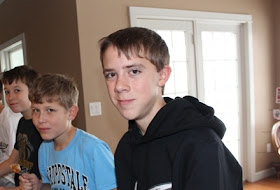When I make brownie pizza, I'm a hero in my own house. I kind of feel like a baking-poser with all that praise, because making brownie pizza is stupid easy. And doesn't it figure that easy recipes are the ones that make your family hug you, but the two-hour recipes with a hundred steps result in a few tastes and "It's good, I'm just not very hungry." Cheesecake? Nope, they won't touch it. Tortes? Not so much. Pie entirely from scratch? Meh. But throw something like this together and it's gone by the end of the day.
In case you have an extra few minutes and want your family to think you belong on the Food Network, try this one out.
Brownie Pizza
Adapted from Taste of Home
Brownie:
3/4 c butter
3 squares unsweetened chocolate
1.5 c sugar
1 tsp vanilla
1.5 c flour
3 eggs
Frosting:
1.5 c powdered sugar
1/2 c peanut butter
2 tsp vanilla
6 T milk
Toppings:
Candies of your choosing
Preheat your oven to 350 degrees. Because this is brownie PIZZA, I would recommend preparing a pizza pan by lining it with nonstick aluminum foil. If you don't have nonstick foil, then butter the pizza pan. I used a large pizza pan with a diameter of about 14 inches. I'm sure you could use a jelly roll pan, but then you probably couldn't call it brownie pizza....
In a saucepan, combine the butter, chocolate and sugar. My strategy to prevent the chocolate from getting stuck to the bottom of the pan and burning is to rest the squares of chocolate on top of the butter. I'm smart like that.
I add the sugar in when the butter is mostly melted and the chocolate is just starting to melt. Whisk the sugar in until everything is melted and smooth. Remove from the heat and stir in the flour. It's important to do this before adding the eggs to give the mixture some time to cool down. If you add the eggs too quickly, the heat from the mixture will scramble them. And that would not be tasty, and you might not get the same type of accolades from your family. Just saying. Anyway, after the flour has been stirred in, quickly stir in the beaten eggs until they are well incorporated. Spread the mixture onto the prepared pizza pan.
Bake for about 15 minutes, or until a toothpick inserted into the center comes out clean. Remove the pizza from the oven, and allow it to cool completely.
I would recommend you make the frosting for this pizza in hiding. Or send your kids outside into the snow to stack wood or scrape the driveway, or give them Clorox wipes and have them clean the bathroom or something. If you don't, you are going to have to share the beaters. Everyone will want them, it will be a fight, and I promise you won't get any.
When the kitchen is cleared, beat the powdered sugar, peanut butter, vanilla and milk until it is light and smooth. Spread the frosting onto the cooled pizza, but consider leaving a copious amount on the beaters and in the mixing bowl so you can "clean them off" before washing them.
Then comes the part that sends this good brownie and amazing frosting right over the edge. The candy on top.
You can use whatever you'd like. We always use M&Ms, but today I included Reese's Pieces and chopped up chocolate-covered cookies I had leftover from a tin from the holidays. Consider chopped up peanut butter cups, chocolate chips, toasted nuts, toasted coconut, or whatever you have in your pantry that looks good.
Then slice it up like a pizza, and eat it with your fingers. Licking peanut butter frosting off your fingers is way better than licking off red sauce from a slice of pepperoni, anyway.
And serious, if I'm going to consume a gob of calories, I'd WAY rather have a pie like this than one covered in greasy cheese and meat. I bet the people you share it with will, too. Maybe you should test it out, but be prepared for the hero status that comes with it. You might not leap buildings with a single bound, but you can surely whip up something scrumptious in a few minutes!




























































